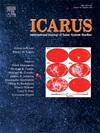评估月球上雷达暗晕陨石坑周围的风化层深度
IF 2.5
2区 物理与天体物理
Q2 ASTRONOMY & ASTROPHYSICS
引用次数: 0
摘要
撞击坑是我们太阳系中普遍存在的地质过程,在塑造包括月球在内的许多行星体的景观方面起着重要作用。我们的研究集中在月球上独特的雷达暗晕陨石坑(RDHCs)上,这些陨石坑被独特的环状结构(即光环)所包围,这些结构具有异常低的雷达反向散射。我们的目的是通过评估RDHCs周围的局部风化层深度来了解RDHCs周围的抛射物就位与月球风化层之间的相互作用。我们使用小撞击坑(~ 10-250 m)的形态来推断这些rdhc周围的风化层深度。我们研究了月球勘测轨道器(LRO)窄角相机(NAC)在五个RDHCs的连续和不连续喷射毯中的图像中的小陨石坑。然后,我们将这些结果与五个非rdhcs的结果进行比较。总的来说,我们观察到RDHCs和非RDHCs周围的风化特征相似。有趣的是,我们的结果并没有显示出火山口年龄和风化层深度之间有很强的相关性。这表明,尽管持续的轰击,风化层并没有随着年龄的增长而明显加深。除了撞击园艺,可能还有其他因素导致月球陨石坑周围的风化层形成。此外,我们的研究表明,与非RDHCs相比,平坦的小陨石坑形态在RDHCs中更占主导地位,这表明这些地区的风化层混合物更深,更均匀。因此,我们的研究表明,细粒RDH物质在基岩上的就位破坏了普通的风化层形成。我们的结论是,仔细地重新检查我们对风化层形成和演化的理解是必要的。本文章由计算机程序翻译,如有差异,请以英文原文为准。
Assessing the depth of the regolith around radar-dark halo craters on the Moon
Impact cratering is a ubiquitous geological process in our Solar System and plays an important role in shaping the landscape of many planetary bodies, including the Moon. Our study focuses on the unique radar-dark halo craters (RDHCs) on the Moon, which are surrounded by distinctive, ring-shaped structures (i.e., haloes) that have unusually low radar backscatter. Our aim is to understand the interaction between the ejecta emplacement around RDHCs and the lunar regolith by assessing the local depths of the regolith surrounding RDHCs. We use the morphology of small impact craters (∼10–250 m) to infer the depth of the regolith around these RDHCs. We examine small craters in images from the Lunar Reconnaissance Orbiter's (LRO) Narrow Angle Camera (NAC) within the continuous and discontinuous ejecta blankets of five RDHCs. We then compare these results with those of five non-RDHCs. Overall, we observe similar regolith characteristics around RDHCs and non-RDHCs. Interestingly, our results do not show a strong correlation between crater age and regolith depths. This suggests that despite continued bombardment, the regolith layer is not getting significantly deeper with age. In addition to impact gardening, there may be other factors contributing to regolith formation around impact craters on the Moon. Additionally, our study suggests that the flat-floor small crater morphology is more dominant for the RDHCs than non-RDHCs, which points to a deeper and more uniform mixture of regolith in these regions. Our study thus suggests that the emplacement of fine-grained RDH material over bedrock disrupts the ordinary regolith formation. We conclude that a careful re-examination of our understanding of regolith formation and evolution is necessary.
求助全文
通过发布文献求助,成功后即可免费获取论文全文。
去求助
来源期刊

Icarus
地学天文-天文与天体物理
CiteScore
6.30
自引率
18.80%
发文量
356
审稿时长
2-4 weeks
期刊介绍:
Icarus is devoted to the publication of original contributions in the field of Solar System studies. Manuscripts reporting the results of new research - observational, experimental, or theoretical - concerning the astronomy, geology, meteorology, physics, chemistry, biology, and other scientific aspects of our Solar System or extrasolar systems are welcome. The journal generally does not publish papers devoted exclusively to the Sun, the Earth, celestial mechanics, meteoritics, or astrophysics. Icarus does not publish papers that provide "improved" versions of Bode''s law, or other numerical relations, without a sound physical basis. Icarus does not publish meeting announcements or general notices. Reviews, historical papers, and manuscripts describing spacecraft instrumentation may be considered, but only with prior approval of the editor. An entire issue of the journal is occasionally devoted to a single subject, usually arising from a conference on the same topic. The language of publication is English. American or British usage is accepted, but not a mixture of these.
 求助内容:
求助内容: 应助结果提醒方式:
应助结果提醒方式:


